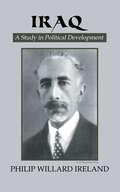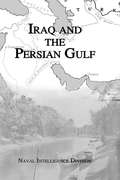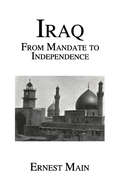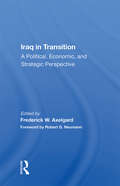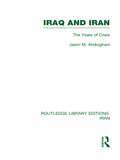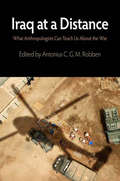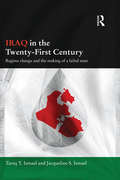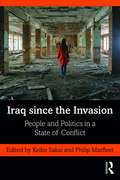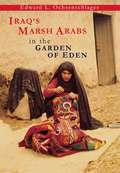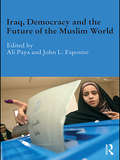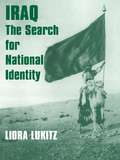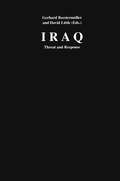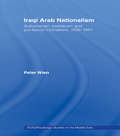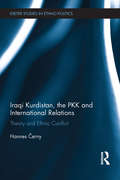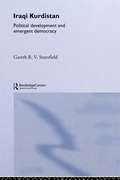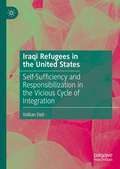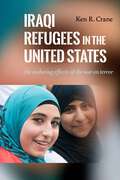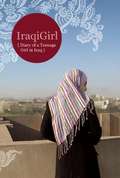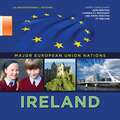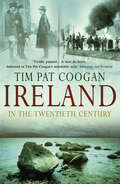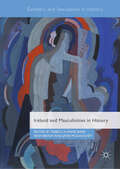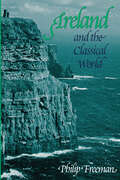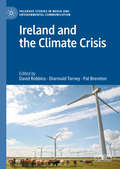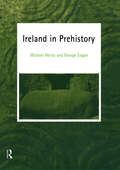- Table View
- List View
Iraq
by IrelandFirst published in 2005. Routledge is an imprint of Taylor & Francis, an informa company.
Iraq & The Persian Gulf
by Naval Intelligence DivisionFirst Published in 2005. Routledge is an imprint of Taylor & Francis, an informa company.
Iraq From Manadate Independence
by Ernest MainFirst published in 2008. Routledge is an imprint of Taylor & Francis, an informa company.
Iraq In Transition: A Political, Economic, And Strategic Perspective
by Frederick W AxelgardAfter twenty-five years of thinly veiled hostility, U.S. relations with post-monarchial Iraq have warmed dramatically. Simultaneously, Iraq's sovereignty has become the keystone of Gulf stability, due to Iraq's military and economic resilience and to the rise of Khomeini's Iran and the waning of Saudi influence. In this book, five leading analysts
Iraq and Iran: The Years Of Crisis (Routledge Library Editions: Iran)
by Jasim M AbdulghaniBehind the Iran-Iraq war rests a history of conflict stretching back to the Ottoman Turks and the Persians. This book examines the deep-seated and complex factors involved in the rivalry between these two nations. It focuses particularly on the period between 1969 and 1984, a time that saw both the rise of the Ba’th party in Iraq and Khomeini’s return to power in Iran. These changes did much to escalate tensions. The Ba’th party’s ideological, socialist regime and its emphasis on political secular concerns stood in marked contrast to Iran under Khomeini and his efforts to spread an Islamic revolution among the nation’s Shiite majority. The author discusses how these differences have affected three long-term problems: Iraq’s and Iran’s rivalry for dominance in the Arabian Gulf region; disputes over the Shatt al-Arab waterway, which serves as a boundary between the two nations; and the Kurdish rebellion in Iraq, supported by Iran. The volume also looks at the most recent episodes of crisis and analyzes the evolution of the Iran-Iraq war and its implications both regionally and globally. Unlike other studies of Iraq’s relations with Iran, Abdulghani’s is distinguished by its systematic and comprehensive synthesis which interlocks legal, cultural, historical and political issues that have characterized relations between the two countries.
Iraq at a Distance
by Antonius C. G. M. RobbenThe Iraq War has cost innumerable lives, caused vast material destruction, and inflicted suffering on millions of people. Iraq at a Distance: What Anthropology Can Teach Us About the War focuses on the plight of the Iraqi people, caught since 2003 in the carnage between U.S. and British troops on one side and, on the other, Iraqi insurgents, militias, and foreign al Qaeda operatives.The volume is a bold attempt by six distinguished anthropologists to study a war zone too dangerous for fieldwork. They break new ground by using their ethnographic imagination as a research tool to analyze the Iraq War through insightful comparisons with previous and current armed conflicts in Cambodia, Israel, Palestine, Northern Ireland, Afghanistan, and Argentina. This innovative approach extends the book's relevance beyond a critical understanding of the devastating war in Iraq. More and more parts of the world of long-standing ethnographic interest are becoming off-limits to researchers because of the war on terror. This book serves as a model for the study of other inaccessible regions, and it shows that the impossibility of conducting ethnographic fieldwork does not condemn anthropologists to silence.Essays analyze the good-versus-evil framework of the war on terror, the deterioration of women's rights in Iraq under fundamentalist coercion, the ethnic-religious partitioning of Baghdad through the building of security walls, the excessive use of force against Iraqi civilians by U.S. counterinsurgency units, and the loss of popular support for U.S. and British forces in Iraq and Afghanistan after the brutal regimes of the Taliban and Saddam Hussein had been toppled.
Iraq in the Twenty-First Century: Regime Change and the Making of a Failed State (Durham Modern Middle East and Islamic World Series)
by Jacqueline S. Ismael Tareq Y. IsmaelMuch has been written about the events surrounding the 2003 Anglo-American invasion of Iraq and its aftermath, especially about the intentions, principles, plans and course of action of US policy, but much less attention has been given to the consequences of US policy on Iraqi political and social development. This book provides an in-depth analysis of the impact of US policy on the social and political development of Iraq in the twenty-first century. It shows how not just the institutions of the state were destroyed in 2003, leaving the way open for sectarianism, but also the country’s cultural integrity, political coherence, and national-oriented economy. It outlines how Iraq has been economically impoverished, assessing the appalling situation which ordinary people, including women and children, have endured, not just as a result of the 2003 war, but also as a consequence of the 1991 war and the sanctions imposed in the following years. The book argues that the social, political, and cultural ruin that accompanied the Iraq war was an absolute catastrophe; that the policies which had such adverse effects were the foreseeable consequences of deliberate policy choices; and that those responsible continue to evade being made accountable.
Iraq since the Invasion: People and Politics in a State of Conflict
by Keiko SakaiThis book addresses the complex events and unexpected outcomes of military intervention by the United States and its allies in Iraq in 2003. Considering the long-term outcomes of the intervention, this volume examines economic collapse, societal disorder, and increased regional conflict in Iraq. The book assesses the means by which American strategists imposed a new political order, generalising corruption, sectarian preference, and ethnic cleansing, and stimulating mass population movements in and from Iraq. Mobilising a multidisciplinary perspective, the book explores the rise and fall of Iraq’s confessional leaders, the emergence of a popular movement for reform, and the demands of young radicals focused upon revolutionary change. The product of years of intensive research by Iraqis and international scholars, Iraq since the Invasion considers how an initiative designed to produce “regime change” favourable to the United States and its allies brought unprecedented influence for Iran—both in Iraq and the wider Gulf region. It analyses events in Kurdistan and the impacts of change on relations between Iraq and its neighbours. The book includes a wealth of detail on political, social, and cultural change, and on the experiences of Iraqis during long years of upheaval. It will be of value to researchers and students interested in international relations, development studies, and Middle East politics.
Iraq's Marsh Arabs in the Garden of Eden
by Edward L. OchsenschlagerWhat can the present tell us about the past? From 1968 to 1990, Edward Ochsenschlager conducted ethnoarchaeological fieldwork near a mound called al-Hiba, in the marshes of southern Iraq. In examining the material culture of three tribes—their use of mud, reed, wood, and bitumen, and their husbandry of cattle, water buffalo, and sheep—he chronicles what is now a lost way of life. He helps us understand ancient manufacturing processes, an artifact's significance and the skill of those who create and use it, and the substantial moral authority wielded by village craftspeople. He reveals the complexities involved in the process of change, both natural and enforced.Al-Hiba contains the remains of Sumerian people who lived in the marshes more than 5,000 years ago in a similar ecological setting, using similar material resources. The archaeological evidence provides insights into everyday life in antiquity. Ochsenschlager enhances the comparisons of past and present by extensive illustrations from his fieldwork and also from the University Museum's rare archival photographs taken in the late nineteenth century by John Henry Haynes. This was long before Saddam Hussein drove one of the tribes from the marshes, forced the Bedouin to live elsewhere, and irrevocably changed the lives of those who tried to stay.
Iraq, Democracy and the Future of the Muslim World (Durham Modern Middle East and Islamic World Series)
by Ali PayaIraq, democracy and Islam are powerful global forces which shape not only many aspects of the lives of Muslims, but the lives of other citizens of the world as well. This book explores many of the challenging questions posed by the interconnections between these three forces, concentrating on issues which have global significance and which have been less studied up until now. It contains contributions from many of the leading thinkers and academics from this subject area, including the former President of Iran, Seyyed Mohammad Khatami. Topics such as the compatibility of Islam and democracy, and the question of whether democracy can be encouraged in the Middle East are looked at carefully. Contributors evaluate the circumstances under which democracy can be imposed by outside force, and asks what forces are driving the confrontation between the West and Islam, before looking at how this confrontation is likely to develop. This book presents a comprehensive picture of dynamic change in the geopolitics of our time, and offers a timely contribution to research on Middle East Politics and Islamic Studies.
Iraq: The Search for National Identity
by Liora LukitzThe 1990-1991 crisis in the Middle East and the disturbances that followed, threw the deep-seated divisions within the Iraqi population into focus. This book examines the complexities of the internal cultural, political and religious conflict within the modern state of Iraq.
Iraq: Threat and Response
by Gerhard BeestermoellerThis volume of essays about the ongoing crisis concerning Iraq is written from the perspective of the "thoughtful opposition." German and American scholars from diverse backgrounds--moral theology, policy analysis, political science, Middle Eastern history--all criticize, albeit sometimes for different reasons, unilateral U.S. military action against Iraq.The chapters are uniformly free of intemperate language and careless argumentation characteristic of much opposition to American foreign policy. The authors address the moral, legal, political, or historical dimensions of the Iraq problem. They also assess the threat Saddam Hussein represents to his region and the world as well as the prospects for alternative strategies. The reasoning is well-informed, sensitive to complexity, and attentive to detail.Contributions include: Klaus Dicke, "Peace Through International Law and the Case of Iraq"; Hans J. Giessmann, "The Dubious Legitimacy of Preventive Military Action against Iraq"; John Langan, "Is Attacking Iraq a Good Idea?" and "Is There a Just Cause for War against Iraq?"; Gerhard Beestermller, "The United States: Legitimate Authority for War against Iraq?"; Drew Christiansen, "Holy See Policy towards Iraq"; Henner Frtig, "Iraq: How Severe is the Threat?"; and David Cortright, Alistair Millar, and George A. Lopez, "Sanctions, Inspections and Containment. Viable Policy Options in Iraq."While Iraq: Threat and Response may not be welcomed by uncritical supporters of U.S. policy, it is a reasoned, compassionate exploration of alternatives to military action in Iraq. The volume is clearly designed to strengthen opposition to unilateral action in the United States and abroad. It will be of great interest to students of foreign policy, military studies, and the Middle East.Gerhard Beestermller is deputy director of the Catholic Institute for Theology and Peace, near Hamburg. His focus of research is political ethics and peace ethics. David Little is T.J. Dermot Dunphy Professor of the Practice in Religion, Ethnicity, and International Conflict and director of Initiatives in Religion and Public Life at Harvard Divinity School. He is the author, with Scott W. Hibbard, of Islamic Activism and U.S. Foreign Policy.
Iraqi Arab Nationalism: Authoritarian, Totalitarian and Pro-Fascist Inclinations, 1932–1941 (SOAS/Routledge Studies on the Middle East)
by Peter WienPeter Wien presents a provocative discussion on the history of Iraq and the growth of nationalism during the 1930s and early 1940s. He deconstructs the established view that a large proportion of the nationalist movement in Iraq during this period was heavily influenced by Nazi Germany, arguing that the admiration for Germany was highly nuanced, and only rarely translated into admiration for Nazism. National unity and patriotism were important, but models of leadership were overwhelmingly based on Iraqis and not Hitler. Analyzing the activities of the Iraqi youth and Jewish Iraqis, Iraqi Arab Nationalism gives an understanding of Iraqis from diverse backgrounds. It incorporates source material not previously used in discussions of Iraq and nationalism and contains autobiographical and biographical material from officers, intellectuals and politicians, along with contemporary journalistic writings, which sheds new light on Iraqi nationalism.
Iraqi Kurdistan, the PKK and International Relations: Theory and Ethnic Conflict (Exeter Studies in Ethno Politics)
by Hannes ČernyDue to its primacy in explaining issues of war and peace in the international arena, the discipline of International Relations (IR) looms large in analyses of and responses to ethnic conflict in academia, politics and popular media – in particular with respect to contemporary conflicts in the Middle East. Grounded in constitutive theory, this book challenges how ethnic/ethno-nationalist conflict is represented in explanatory IR by deconstructing its most prominent state-centric models, frameworks and analytical concepts. As much a critique of contemporary scholarship on Kurdish ethno-nationalism as a detailed analysis of the most prominent Kurdish ethno-nationalist actors, the book provides the first in-depth investigation into the relations between the PKK and the main Iraqi Kurdish political parties from the 1980s to the present. It situates this inquiry within the wider context of the ambiguous political status of the Kurdistan Region of Iraq, its relations with Turkey, and the role Kurdish parties and insurgencies play in the war against ISIS in Iraq and Syria. Appreciating these complex dynamics and how they are portrayed in Western scholarship is essential for understanding current developments in the Iraqi and Syrian theatres of war, and for making sense of discussions about a potential independent Kurdish state to emerge in Iraq. Iraqi Kurdistan provides a comprehensive and critical discussion of the state-centric and essentialising epistemologies, ontologies, and methodologies of the three main paradigms of explanatory IR, as well as their analytical models and frameworks on ethnic identity and conflict in the Middle East and beyond. It will therefore be a valuable resource for anyone studying ethnicity and nationalism, International Relations or Middle East Politics.
Iraqi Kurdistan: Political Development and Emergent Democracy (Routledge Advances in Middle East and Islamic Studies #No.1)
by Gareth R. StansfieldThe Iraqi Kurds have enjoyed de facto statehood in the north of Iraq for over a decade but Intra-Kurdish fighting, military incursions by Turkey and Iran and the constant threat posed by Saddam Hussein have plagued this 'democratic experiment'. In this book, Stansfield explores the development of the Kurdish political system since 1991. He examines the difficult and often violent relations between the two dominant powers, the Kurdistan Democratic Party (KDP) and the Patriotic Union of Kurdistan (PUK), and their relationship with the Kurdish Regional Government in order to understand the current state of Iraqi Kurdish politics and the operation of the state.This topical in-depth study identifies the main dynamics of Iraqi Kurdish politics, analyzes the record and potential of the 'Kurdish democratic experiment', and identifies the present and future Kurdish leaders.
Iraqi Refugees in the United States: Self-Sufficiency and Responsibilization in the Vicious Cycle of Integration
by Volkan DeliIn the literature on forced migration, little is known about the experiences of Iraqi refugees resettled in the United States through the US Refugee Admissions, Reception and Placement Program. As part of its longstanding refugee resettlement policy, the United States has accepted and provided safe haven to thousands of refugees. Focusing primarily on the situation of Iraqis resettled in Arizona since the 1990s, this research uses interview findings and first-hand data to examine various aspects of their post-resettlement experiences through a meta-theoretical approach that includes aspects of humanitarian governance, adaptation, acculturation and integration. Building on this theoretical understanding, this book examines the process from the first moment of resettlement to integration as a multi-layered social reality and reveals the fundamental impact of forced migration on the 'politics of refugee life'. By examining the US resettlement program in relation to the role and functions of resettlement agencies and non-profit organizations in collaboration with the government, this book highlights the fundamental difference between refugee integration and migrant integration, introduces new concepts of integration, discusses the US refugee admissions, reception and placement program and refugee integration in relation to the organization of humanitarian governance globally, and offers recommendations for improving resettlement and integration processes.
Iraqi Refugees in the United States: The Enduring Effects of the War on Terror
by Ken R. CraneHow Iraqi refugees navigate life, belonging, and exclusion in AmericaThe US invasion of Iraq in 2003 caused the largest forced migration in the Middle East since 1948, with millions of people fleeing to Syria, Jordan, Turkey, Iran, European Union, Australia and the United States. In Iraqi Refugees in the United States, Ken R. Crane explores the uphill climb faced by Iraqi refugees who have sought belonging in a country engaged in an ongoing War on Terror. Drawing on numerous interviews and fieldwork, Crane explores the diverse experiences of a community of Iraqi refugees, showing how they have struggled to negotiate their place in the wake of mass displacement. He highlights the promise of belonging, as well as their many painful encounters with exclusion. Ultimately, Crane provides a window into the complexities of what “becoming American” means for Iraqi refugees, even as they are perceived by other Americans as “security threats.”As debates about immigration and refugee status continue to play out in headlines and the courts, Iraqi Refugees in the United States provides important insight into the global refugee crisis.
Iraqigirl: Diary of a Teenage Girl in Iraq
by Elizabeth Wrigley-FieldHadiya began her blog just under a year and a half into the U.S. occupation of Iraq. She writes from Mosul, a diverse city with many Sunni Muslims, like Hadiya's family. Mosul has become one center of resistance to the occupation. Hadiya's name is not really Hadiya. We have used pseudonyms for every Iraqi in this story because each of their lives could be in danger if they were identified. But Hadiya is a real teenager in Mosul, and this is her story.
Ireland (Major European Union Nations)
by Ida WalkerNot long ago, Ireland was a country dealing with poverty and violence. Today, it has turned around and is now a peaceful nation. Ireland became a member of the EU in 1973. Its history also includes the Catholic Church, the potato famine, and long struggles for freedom. While Ireland's economy is currently doing poorly because of the global recession, it is working hard to recover. Discover more about this exciting, modern nation!
Ireland In The 20th Century
by Tim Pat CooganIreland's bestselling popular historian tells the story of contemporary Ireland - controversial, authoritative and highly readable. Tim Pat Coogan's biographies of Michael Collins and DeValera and his studies of the IRA, the Troubles and the Irish Diaspora have transformed our understanding of contemporary Ireland, and all have been massive bestsellers. Now he has produced a major history of Ireland in the twentieth century. Covering both South and North and dealing with cultural and social history as well as political, this enthralling work will become the definitive single-volume account of the making of modern Ireland.
Ireland and Masculinities in History (Genders And Sexualities In History Ser.)
by Sean Brady Rebecca Anne Barr Jane McGaugheyThis edited collection presents a selection of essays on the history of Irish masculinities. Beginning with representations of masculinity in eighteenth-century drama, economics, and satire, and concluding with work on the politics of masculinity post Good-Friday Agreement in Northern Ireland, the collection advances the importance of masculinities in our understanding of Irish history and historiography. Using a variety of approaches, including literary and legal theory as well as cultural, political and local histories, this collection illuminates the differing forms, roles, and representations of Irish masculinities. Themes include the politicisation of Irishmen in both the Republic of Ireland and in Northern Ireland; muscular manliness in the Irish Diaspora; Orangewomen and political agency; the disruptive possibility of the rural bachelor; and aspirational constructions of boyhood. Several essays explore how masculinity is constructed and performed by women, thus emphasizing the necessity of differentiating masculinity from maleness. These essays demonstrate the value of gender and masculinities for historical research and the transformative potential of these concepts in how we envision Ireland’s past, present, and future.
Ireland and the Classical World
by Philip FreemanOn the boundary of what the ancient Greeks and Romans considered the habitable world, Ireland was a land of myth and mystery in classical times.<P><P> Classical authors frequently portrayed its people as savages—even as cannibals and devotees of incest—and evinced occasional uncertainty as to the island's shape, size, and actual location. Unlike neighboring Britain, Ireland never knew Roman occupation, yet literary and archaeological evidence prove that Iuverna was more than simply terra incognita in classical antiquity. <P> In this book, Philip Freeman explores the relations between ancient Ireland and the classical world through a comprehensive survey of all Greek and Latin literary sources that mention Ireland. He analyzes passages (given in both the original language and English) from over thirty authors, including Julius Caesar, Strabo, Tacitus, Ptolemy, and St. Jerome. To amplify the literary sources, he also briefly reviews the archaeological and linguistic evidence for contact between Ireland and the Mediterranean world. <P> Freeman's analysis of all these sources reveals that Ireland was known to the Greeks and Romans for hundreds of years and that Mediterranean goods and even travelers found their way to Ireland, while the Irish at least occasionally visited, traded, and raided in Roman lands. Everyone interested in ancient Irish history or Classics, whether scholar or enthusiast, will learn much from this pioneering book.
Ireland and the Climate Crisis (Palgrave Studies in Media and Environmental Communication)
by David Robbins Pat Brereton Diarmuid TorneyThis book provides a comprehensive overview of Ireland’s response to the climate crisis. The contributions, written by leading scholars across a range of disciplines in the social sciences, humanities and beyond, shed light on diverse aspects of the climate crisis, the factors shaping Ireland’s response, and prospects for the future. Long regarded as a ‘climate laggard’, Ireland’s response to the urgent societal challenge of climate change has seen new momentum in recent times. The volume will serve as a key reference point for academics, students, policymakers, and a wide range of stakeholders. It will be of interest to readers within Ireland, as well as further afield, who wish to gain a deeper understanding of the constraints on, and opportunities for, successful climate action in Ireland.
Ireland and the Irish in Interwar England
by Mo MoultonTo what extent did the Irish disappear from English politics, life and consciousness following the Anglo-Irish War? Mo Moulton offers a new perspective on this question through an analysis of the process by which Ireland and the Irish were redefined in English culture as a feature of personal life and civil society rather than a political threat. Considering the Irish as the first postcolonial minority, she argues that the Irish case demonstrates an English solution to the larger problem of the collapse of multi-ethnic empires in the twentieth century. Drawing on an array of new archival evidence, Moulton discusses the many varieties of Irishness present in England during the 1920s and 1930s, including working-class republicans, relocated southern loyalists, and Irish enthusiasts. The Irish connection was sometimes repressed, but it was never truly forgotten; this book recovers it in settings as diverse as literary societies, sabotage campaigns, drinking clubs, and demonstrations.
Ireland in Prehistory
by George Eogan Mr George Eogan Michael HerityThe authors examine Irish prehistory from the economic, sociological and artistic viewpoints enabling the reader to comprehend the vast amount of archaeological work accomplished in Ireland over the last twenty years.
